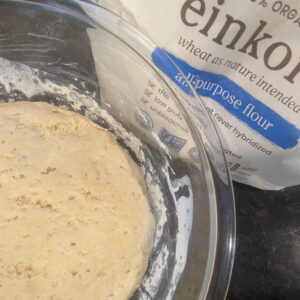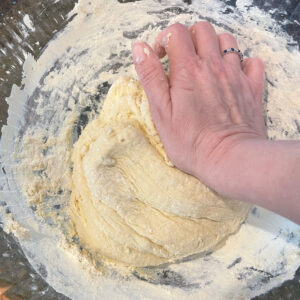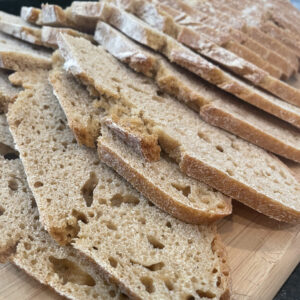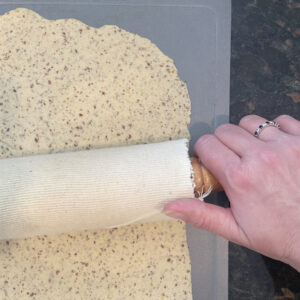 I have been baking with my einkorn sourdough starter since the beginning of my wellness journey in 2018. I started baking with sourdough in 2016 (yes, my starter is 8 years old!), but white flour was spiking my blood sugar and I really wanted to continue eating bread! Lots of research led me to einkorn as an alternative. Higher in protein and slower to assimilate, it doesn’t raise blood sugar as quickly as modern hybridized white flour. It’s also delicious, although denser with a different texture than modern wheat. I converted my white flour starter and have been baking with einkorn almost exclusively ever since! It can be a bit time intensive but it is so fun and I am constantly looking for new ways to make einkorn sourdough versions of everything!
I have been baking with my einkorn sourdough starter since the beginning of my wellness journey in 2018. I started baking with sourdough in 2016 (yes, my starter is 8 years old!), but white flour was spiking my blood sugar and I really wanted to continue eating bread! Lots of research led me to einkorn as an alternative. Higher in protein and slower to assimilate, it doesn’t raise blood sugar as quickly as modern hybridized white flour. It’s also delicious, although denser with a different texture than modern wheat. I converted my white flour starter and have been baking with einkorn almost exclusively ever since! It can be a bit time intensive but it is so fun and I am constantly looking for new ways to make einkorn sourdough versions of everything!
So, what is einkorn flour?
The einkorn grain is the original ancient wheat from which all modern wheats have been hybridized. Older than spelt or emmer, it’s roots date back to the Fertile Crescent (think ancient Mesopotamia!). As the most primitive form of wheat, it has less chromosomes than modern wheat and is missing the one that seems to cause most wheat intolerances, making it more easily digestible. It takes longer to grow compared to modern wheat though, and it’s hulled (the berries are packed tightly together enclosed in a husk) so harvesting is more labor-intensive. Many modern wheats have been hybridized from einkorn to be free-threshing and easier to cultivate. Unfortunately most of the nutrients and good stuff are also stripped away in the process, which is one of the reasons modern white wheat is so unhealthy. It’s also sprayed liberally with glyphosate before harvest (unless it’s organic), which has devastating consequences for our bodies.
 Where can you buy einkorn flour?
Where can you buy einkorn flour?
I buy 10-lb bags of all-purpose flour straight from the Jovial Foods website. I buy 4 packages at a time to save on shipping and then store in one of those airtight dog food containers. You can also buy from Amazon though, and they have the smaller 2-lb bags. Locally, the smaller bags can be found at Sprouts and MOM, but they are pricier in-store.
If you check out the Jovial website, you’ll see they also sell unmilled wheat berries. Although this is the absolute best way to maintain the highest nutrient content of wheat, I just have never found the time to bite off milling my own flour. Maybe one day, but not anytime soon! I do, however, keep some whole grain flour on hand to mix into some of my recipes.
Why is einkorn better?
For many reasons, einkorn is a superior flour alternative. It has a gentler form of gluten that lacks the high molecular weight proteins many people can’t digest, making it an excellent option for those who are gluten sensitive. I’ve known many people over the years who cannot eat gluten but can tolerate einkorn! This is great news because most of the GF flour options are really not that healthy and have a very high glycemic index.
Einkorn also:
- Contains 3-4 times more beta-carotene (boosts immunity and prevents cancer and heart disease) than modern wheat
- Has two times more vitamin A than modern wheat (healthy eyes and reproductive organs, prevents cancer)
- Has 3-4 times more lutein than modern wheat (prevents macular degeneration and cataracts)
- Contains 4-5 times more riboflavin than modern wheat (antioxidants to slow aging and used to create energy)
- Has a higher protein content than even wheat durum (which is the wheat that commercial whole grain bread products are made from)
- Contains half the phytic acid (which lowers nutrient absorption blockage) of modern wheat
 Why sourdough?
Why sourdough?
For many, many reasons, fermenting flour to create a sourdough bread has significant benefits. I’ve written before about the why sourdough is a much better bread alternative, so please check that post out HERE. In general though, the sourdough process breaks down the sugars, pre-digests the gluten, adds more nutrients, makes all nutrients more bio-available, and offers gut-healthy probiotics.
Making an einkorn sourdough starter
First things first, you need a sourdough starter! I purchased a dehydrated sourdough starter from Cultures for Health and followed their directions to get it going, but the easiest way to get started would be to obtain some active starter from a friend. An active starter can be used immediately without having to build it up. If you’re local, I am happy to share starter! You can convert any starter to the flour you want – simply start “feeding” it with the desired flour. A couple days of feeding with the new flour will be perfect, it’s super simple!
Sourdough starter replaces the need for dehydrated yeast. By keeping it around all the time, you can bake just about anything you want. You’ll just pull a bit of the starter (measured based on the recipe) to use when mixing the dough, and then follow the rest of the directions. One major difference you’ll notice in recipes is a much longer proof time compared to yeast breads. This is a good thing – it gives the starter lots of time to work its magic and makes it taste yummy!
 Maintaining an einkorn sourdough starter
Maintaining an einkorn sourdough starter
- Jar. You’ll need a covered jar that is not airtight to store your starter. Starter needs air to complete the fermentation process. I really like the half-gallon Anchor Hocking glass jar for my einkorn starter. It stays on my counter away from other ferments (mold can start if different ferments are kept too close together).
- Cleaning. It may be an unpopular choice, but I only clean my jar when it gets yucky (which probably equates to about once a week). Everyone has a different tolerance for “yucky” but I’m not trying to spend more time cleaning than I have to! Don’t wait too long though, or mold may develop where there is residue on the jar.
- Starter Amount. A small amount of starter must always be kept – do not use it all up while baking or there won’t be any leftover to use for future baking. Because einkorn is expensive, I keep the amount of my einkorn starter relatively low unless I need to build it up to bake.
- Feedings. Starter is typically “fed” twice a day with roughly equal parts flour and water. I maintain my starter morning and evening. For einkorn, I use a ratio of 1/4 cup starter, 1/4 cup flour, and a scant 1/4 cup water when I am just maintaining (and not building it up to bake with it). To feed, I discard (dump into the trash) enough starter to leave approximately 1/4 cup left in the jar. You’ll probably start by measuring it but you’ll be able to eyeball it rather quickly to save a step. Add to that the flour and water, and then mix. Heads up, einkorn flour does not mix well. It takes a bit of effort but keep at it! Then cover the jar with the glass top and leave it.
- Discard. Feeding a sourdough starter includes discarding (throwing away) some of it. Otherwise, your starter will become massive and you’ll have to keep adding large amounts of flour to it. Not only will you run out of room in your jar, it’ll get really expensive to maintain! It’s unfortunate but it’s just part of the process. Resist the urge to save or use up all the discard – it’ll get overwhelming and you’ll be baking nonstop.
- Water. Use filtered water, especially if you are on city water. You don’t want fluoride or chlorine in your starter because it can kill off the yeast and bacteria you need. I love Berkey or Clearly Filtered.
- Starter Consistency. There is a lot of science out there about hydration levels and all kinds of things … I have never gotten into that. I just trust the process. I like for my starter to have the consistency of a waffle batter – a little lumpy and thick, not runny. A bit of extra flour or water during feedings can be added to get the desired consistency – it doesn’t need to be a perfect science! It’s important to know that einkorn starter bubbles, but it does not grow like white flour. It pretty much stays about the same volume all the time. You’ll know it’s working correctly when you see the bubbles on top. It also smells differently than white flour starter. It has a pleasant odor, but is not as “bready” or “yeasty.”
- Taking a Break. You can refrigerate your starter when you need to take a break or will be on vacation! Simply feed the starter like normal and then leave it out for a few hours to start the fermenting process. Transfer to a smaller container (I like the wide mouth pint-sized mason jar) and cover it with an airtight top to refrigerate. I prefer to keep it on the door so it doesn’t accidentally get pushed to the back because parts of my refrigerator can actually freeze food. Don’t stress too much though – I successfully revived an accidentally-frozen starter and it’s still going strong. Starter can be left in the fridge for a couple weeks if needed. It will definitely separate and look a little weird – that’s normal. I just mix it all back together before feeding. If you want to store it more long term, simply pull out the starter every couple weeks and let it get to room temperature. Feed it like normal, let it sit for a few hours, and then re-refrigerate. It’s a great way to maintain a starter if you don’t bake all the time.
- Strategize. One strategy to consider is doing all your baking over several days and then refrigerating your starter when not in use. I did this regularly when I was working outside the home and it worked perfectly. I’d bake everything on the weekends to freeze, and then we’d have bread, pancakes, crepes, etc. to pull from during the week. Just about everything freezes beautifully and can then be toasted or thawed to enjoy later.
 Using an Einkorn Sourdough Starter
Using an Einkorn Sourdough Starter
- Using Fed Starter. Once you have your einkorn sourdough starter regularly fed and active, it’s time to bake with it! For almost all recipes, you are using “fed” starter, meaning it’s hungry and it has been about 8-12 hours since the last feed. The recipe will let you know if it requires something different.
- Building Up the Starter. You’ll need to pay attention to how much starter is required for the recipe you want to bake. If it’s a larger amount (more than a 1/2 cup), you’ll need build up the starter with a feed before making the recipe. So, instead of keeping the normal 1/4 cup of starter to feed with a 1/4 cup of flour and a scant 1/4 cup of water, you’ll keep maybe a 1/2 cup of starter to feed with a 1/2 cup of flour and a scant 1/2 cup of water. The amount you need to build up is dependent on how much starter your recipe calls for. For most of my recipes, building up with a 1/2 cup of starter is typically sufficient.
- Save Some Starter. It’s a bit of trial and error but always remember that you need to keep some starter every time you bake. Even if it’s just 1/3 of a cup, you need to maintain at least a tiny bit to feed so you don’t run out.
 Troubleshooting
Troubleshooting
- Forgetting a Feed. It can be easy to forget a feeding. Don’t stress if that happens. Starter is very forgiving, especially in the winter when the temperature is cooler. When I was sick years ago, I think I actually missed two feedings and was able to save it. Don’t be alarmed when your starter separates at the top and looks kind of yucky. Just mix all of that up and then discard as usual.
- Fruit Flies. Especially in the summer, starter can attract fruit flies. It’s rare that a fruit fly will get into the starter, but it happens. Just pick it out and keep going. Consider adding a layer of cheesecloth under the top in the summer – this will 100% keep fruit flies out of your starter.
- Weird Coloring. When einkorn starter has been neglected (missed feedings), the starter separates and looks weird. You’ll notice darker gray tinges of liquid in the starter, but it’s still ok! That’s a normal sign that the starter needs to be fed. As long as there is no mold in the starter, mix it all back together and just keep going.
- Strong Smell. If feedings are missed, the starter will get a very strong, stinky, sour smell. It’s ok – as long as there’s no mold in the starter, just feed it and keep going.
Getting Started!
Einkorn behaves differently than modern hybridized wheat. It absorbs less water, which makes a stickier dough that can be a bit difficult to work with. The benefit, though, is that lots of kneading isn’t necessary! Instead of adding extra flour, the best thing to do is give the dough extra time to absorb liquids (another reason that sourdough is ideal!). Also, using a liberally-floured work surface is essential. If you are trying to substitute einkorn for a white flour recipe, it is suggested to reduce liquids by about 25-50%. It takes some trial and error though, so don’t give up if you don’t succeed right away.
The easiest way to get started is by using einkorn-specific recipes. You’ll find a lot of my favorites on my blog HERE, but there are options all over Pinterest as well. I would consider starting with the Einkorn Sourdough Loaf or the Overnight Einkorn Sourdough Pancakes but my family also loves the Einkorn Sourdough Crackers and Sourdough Crepes!
![]()
 TIME TO START YOUR HEALING JOURNEY
TIME TO START YOUR HEALING JOURNEY
Statistics show that 60% of adults and over 50% of children are suffering from chronic health conditions. And to make matters worse, 33% of our children have experienced at least one adverse childhood experience (ACE).
Let’s heal our health. Join me in the journey to create natural, wholistic, healing homes that offer safe havens where our families can connect, thrive, and find joy in wellness. When we fuel our bodies properly, practice the self-care we need, and experience connecting relationships, we can all resiliently thrive together and fulfill our God-given purposes.
SIGN UP to receive empowering email messages to help your family find healing through self care, wholistic wellness, and connected parenting.
.png)







